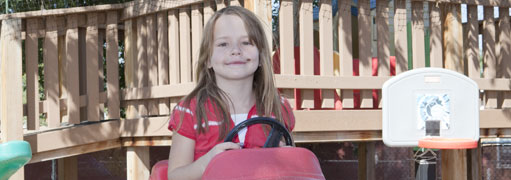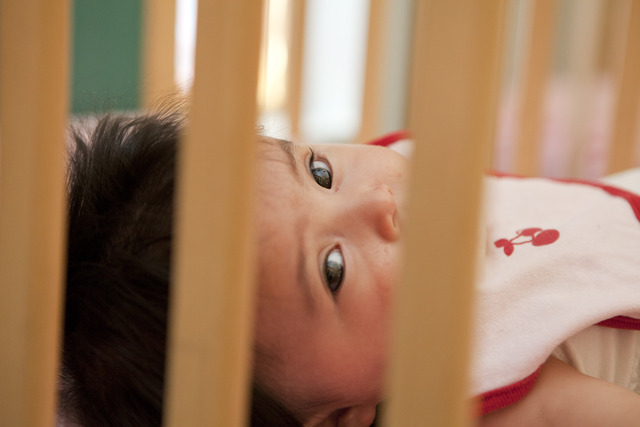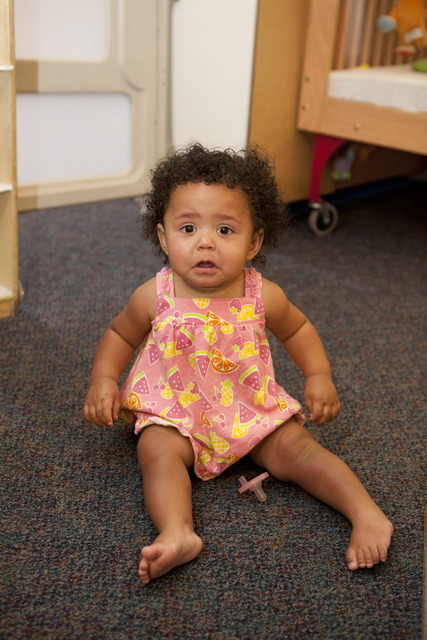Through the Eyes of a Child
A tidy, well-kept building glimmers beneath the New Mexico sun. The cheerful chatter of playing escapes past protective fencing that encircles the playground. It may look like an upscale preschool, but that fence hints at the dire situations these children face outside the secure walls of the Cuidando facility. Cuidando kids often come from volatile domestic situations, so security features like locks and fences are critical to everyone’s safety. A sturdy little bus has just returned from its three-hour morning trek. The volunteer bus driver, Richard, leaves at the crack of dawn to pick up Cuidando children from all nooks and crannies of the city. Because transportation can be an insurmountable obstacle for homeless families, this little bus is indispensable to Cuidando’s work. It’s obvious that the place is bright and friendly. But to truly appreciate this facility, you have to try to see things through the eyes of a homeless child. According to the National Center, 97 percent of homeless children have moved within the past year, 22 percent have been separated from their family and one in four have witnessed violence. Two-thirds of homeless kids worry that they won’t have enough to eat. At Cuidando, the kids never have to go without nutritious food, warm clothing or clean diapers. Unlike the crowded shelters or fleabag motels some are used to, the rooms here are neat and pretty. Adults shower you with warmth and treat your family with respect. Multilingual teachers introduce new concepts in English, Spanish and Navajo. Mealtime is family-style, with everyone sitting together around a big table. This ushers in lessons about manners and sharing. The kids begin to learn the value of personal space by decorating their very own little cubbies. They stretch their legs in the sunny play areas around the outdoor garden. Even in this safe new place, the hostile world of homelessness lurks in memories. Some worry so much they cry or fight or even remain silent for days. Over time, they learn to voice their traumatic experiences through artwork, language and play.Anatomy of a Successful Program
Cuidando is beautiful environment for any child, which is why it’s nationally accredited and state licensed with a five-star rating from the Children, Youth and Families Department. But for a kid living on the brink of the abyss, this place can be lifesaving. “My son came [to Cuidando] in just a T-shirt,” says Cuidando mom Pam of her 2-year-old son, Michael. “Now he’s talking more. He has learned so much. He’s learned sign language. That’s where he learned how to walk,” she says. Before coming to Cuidando, Pam and her son were sleeping on the floor at an emergency shelter with 100 other people. Babies living in these circumstances can develop physical delays, since a crowded shelter floor is not a safe space for small children to practice skills like rolling over, crawling and walking. But Michael is now on track with his health and development, which shows in his quick smile and strong legs. Pam herself is back on track as well. She has an apartment and is studying liberal arts at CNM. “I haven’t been in school in over 25 years, and I’m loving it,” she says with a laugh. “Without Cuidando I wouldn’t be where I’m at now.” Like Pam, single mom Christine has also found success through Cuidando. She and her 7-year-old son Lucas have been out of the program for five years now. Christine, who is earning a degree in business administration at CNM, says her family has been stable since leaving the program. Lucas, a soon-to-be second-grader, is doing well in school and loves family games. Though Christine and Lucas have not re-experienced homelessness since leaving Cuidando, the memories of her former life are never far from her thoughts. “There’s always an underlying fear,” she says. “Do I have enough money? Can I pay the rent? You feel so violated and humiliated that you don’t know how to speak up.” Cuidando’s program is built around a deep understanding of the sense of violation and voicelessness that Christine talks about. Dr. Tamez calls this “trauma-informed care,” and Cuidando’s leadership has won the program a three-year grant to develop training modules that will help other organizations meet the special needs of homeless families. The U.S. State Department even asked Dr. Tamez to travel to Paraguay last year to share Cuidando’s model with officials seeking to address child homelessness in their country.A Village of Advocacy
Families cannot pull themselves out of homelessness if they’re isolated and lacking basic resources. Likewise, Cuidando itself cannot provide the numerous services it offers to families without its network of partner organizations, donors and volunteers. One such partner organization, Albuquerque Health Care for the Homeless, runs Cuidando’s weekly onsite health clinic. Others, such as Saranam and CNM, provide access to essentials such as housing and education. The lengthy list of partnerships represents a statewide alliance working to end child homelessness in New Mexico. Despite these efforts and Cuidando’s success, New Mexico has a long way to go. The National Center on Family Homelessness has ranked our state a dismal 47t] in the country for child homelessness. New Mexico scores poorly when it comes to the number of homeless children, a child’s risk of becoming homeless and overall child well-being.That means fewer than 25 percent of homeless kids graduate from high school. It means homeless kids are four times more likely to have health problems than their non-homeless counterparts, and they have a 50 percent chance of developing mental health problems like anxiety and depression. It means that Cuidando, which serves about 120 children between infancy and 5 years of age and about 90 parents per year, cannot keep pace with the needs of the estimated 10,000 homeless children in Albuquerque alone. Cuidando and its partner organizations have launched the New Mexico Campaign to End Child Homelessness, which authored a report at the request of the state Legislature. Of the report’s many policy recommendations, Tamez says that ensuring access to quality, affordable housing is the most important. He argues that there’s a major misconception about what affordable means. According to the National Low Income Housing Coalition, a single New Mexican parent earning minimum wage must work 73 hours per week, 52 weeks per year, in order to afford a two-bedroom apartment.“In the long run, what we need is a permanent place where a family can become established,” Tamez says. Although efforts to provide shelters or transitional housing are important short-term solutions, these environments don’t allow for the security and stability that families with children need.The report also calls for increased access to early childhood development and care. “Early childhood is the most powerful investment a country can make,” a World Health Organization Report says, “with returns over the lifecourse many times the amount of the original investment.” This is especially true when programs reach disadvantaged kids. But since Cuidando is one of only seven programs offering early childhood development services to homeless kids in the entire nation, there’s work to be done. With strong policies and partnerships, the New Mexico report to the legislature says that ending child homelessness in our state is possible. “We are doing it,” says Tamez. “We just need to do it on a larger scale.”Ask Reina, who’s now finishing a degree in business management. Still clutching Sammie in her arms, she holds back tears as she speaks. “I believe I became homeless for a reason,” she says. “To make my voice heard. To advocate for others. We must be willing to invest in our future, our greatest asset, our children.”Several names have been changed to protect the anonymity of our sources.
Data:• Cuidando los Niños, A Home for Every Child (2011). Estimates of homeless children and youth in New Mexico, 2011 Update. Unpublished data. Estimate based on published McKinney-Vento homeless student data (N.M. Public Education Department, 2011) adjusted to account for children under the age of 6 (Urban Institute, 1999).• The National Center on Family Homelessness (2009). America’s Youngest Outcasts: State Report Card on Child Homelessness . Newton, MA. PDF: http://www.homelesschildrenamerica.org/pdf/rc_full_report.pdf• N.M. Coalition to End Homelessness (2011). 2011 Point in Time Count Results; U.S. Dept. of Housing and Urban Development (HUD) (2007). Annual Homeless Assessment Report to Congress. PDF: www.huduser.org/publications/pdf/ahar.pdf • National Low Income Housing Coalition (2011). Out of Reach 2010.• Cuidando los Niños (2011). Unpublished data.













